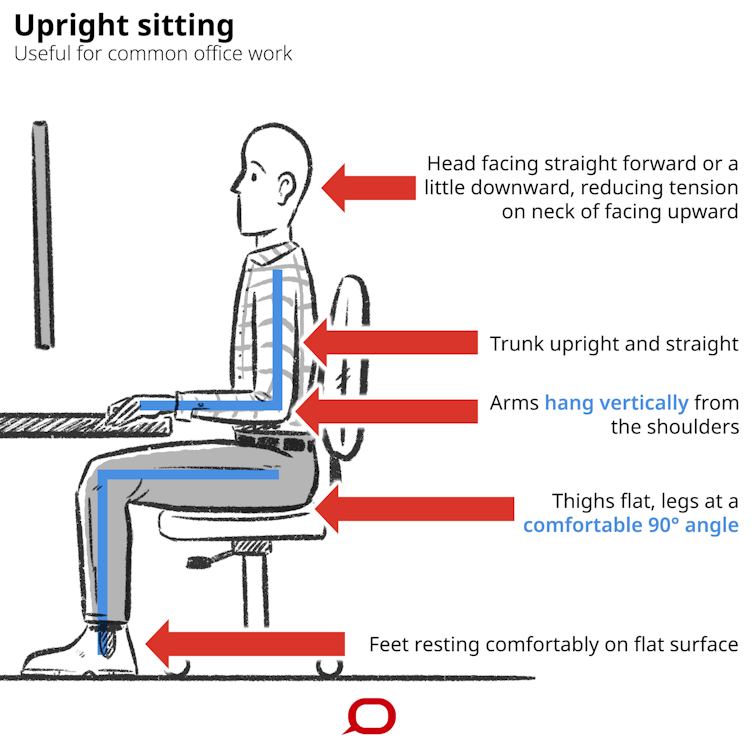Get a proper chair, don't eat at your desk, and no phones in the loo – how to keep your home workspace safe and hygienic
- Written by Libby Sander, Assistant Professor of Organisational Behaviour, Bond Business School, Bond University

The onset of COVID-19 saw a dramatic shift, with many in the workforce suddenly finding themselves working from home. As hashtags sprung up on social media documenting makeshift work-from-home setups, it rapidly became evident that for many workers, their new improvised workspace fell well short of ideal.
Far from having a separate home office, it emerged many employees didn’t even have a desk, as social media teemed with photos of kitchen tables, ironing boards, upturned laundry baskets and even the top of a fridge as an improvised standing desk.
While Winston Churchill used to work in bed in his pyjamas and John Lennon tried to change the world from between the sheets, research suggests working on your laptop on the couch or from bed is less than ideal for our health.
How do I set up my home workspace?
Musculoskeletal disorders are the most common work-related injury in Australia, accounting for 55% of serious workers’ compensation claims in 2015-16.
A proper ergonomic setup has been shown to reduce problems such as muscle strains, lower back injuries and tendonitis, as well as decreasing muscle fatigue and enhancing productivity.

The Conversation, CC BY-ND If you can’t access a separate work desk, a flat surface is vital, and a proper ergonomic chair is a must. Some employers are allowing their staff to take their office chair home, so ask your employer if this is possible. Fresh air and natural light are important, as is considering your posture while working. The UK Chartered Institute of Ergonomics and Human Factors suggests several practical steps employees can take to set up their workspace and stay healthy while working from home. An egg chair would be a comfortable working space.

Chartered Institute of Ergonomics and Human Factors Physical movement and taking regular breaks will also help our physical and mental well-being. Stay hydrated, go for a walk outside and stretch regularly. Don’t stay sitting for hours on end, which is easily done when you are on endless Zoom calls. Read more: 5 reasons why Zoom meetings are so exhausting Keeping your home workspace hygienic While an ergonomic home workplace presents challenges, our exposure to germs will be constant. Our home workplace is also a haven for microbes: the typical office desk is home to more than 10 million bacteria. So never think you are working alone! Your monitor, keyboard, computer, mouse, office files, chair and personal items are all reservoirs for microbes, which are mainly deposited via our hands, skin and hair. Given the COVID-19 pandemic has turned us all into armchair virologists, you’ll doubtless already know these microbes include virus particles, especially if you have contracted an infection and keep working at home. With an ongoing infection, you should seek medical help and take time off sick. Resist the temptation to keep working, even from home. Soldiering on has two drawbacks: not only are you spreading germs all over your desk, but by stressing yourself by working when ill, you can weaken your immune system and reduce your ability to fight the infection. Read more: What is a virus? How do they spread? How do they make us sick? In any case, healthy or sick, practising good hygiene is essential. When returning home, take your shoes off and wash your hands thoroughly to prevent the intrusion of outdoor microbes into your home environment. Good hand hygiene is one of the most effective ways to reduce germ transmission. Your home work desk should be uncluttered and clean, and should be wiped down frequently with ordinary detergent. To clean your keyboard, monitor and other equipment, first unplug them, then dust with a soft microfibre cloth before wiping with a moist alcohol or detergent wipe. Do not eat at your desk, unless you want a side order of microbes with your sandwich. Wipe and disinfect your phone regularly – it hosts all sorts of pathogens, potentially including faecal material. Resist the urge to take your phone into the bathroom, especially if you enjoy scrolling during your lunch! Read more: Mobile phones are covered in germs. Disinfecting them daily could help stop diseases spreading While it is impossible to eradicate all microbes, good hygiene and regular cleaning will keep your home work space safer. And while it might seem obvious, washing your hands after going to the bathroom is not done in the workplace as much as we might imagine. Finally, coffee cups and coffee makers, while vital to the work-from-home economy, can also harbour unwanted bacteria and other microbes, so make sure they are cleaned regularly.
 Not the ideal start to the day. Shutterstock Having enjoyed the benefits of working from home, recent surveys suggest many employees want to carry on, for at least part of their working week. A safe and hygienic work environment in the home is essential to maximise the benefits, and to reduce the risk of injury and illness.
Not the ideal start to the day. Shutterstock Having enjoyed the benefits of working from home, recent surveys suggest many employees want to carry on, for at least part of their working week. A safe and hygienic work environment in the home is essential to maximise the benefits, and to reduce the risk of injury and illness. Authors: Libby Sander, Assistant Professor of Organisational Behaviour, Bond Business School, Bond University





